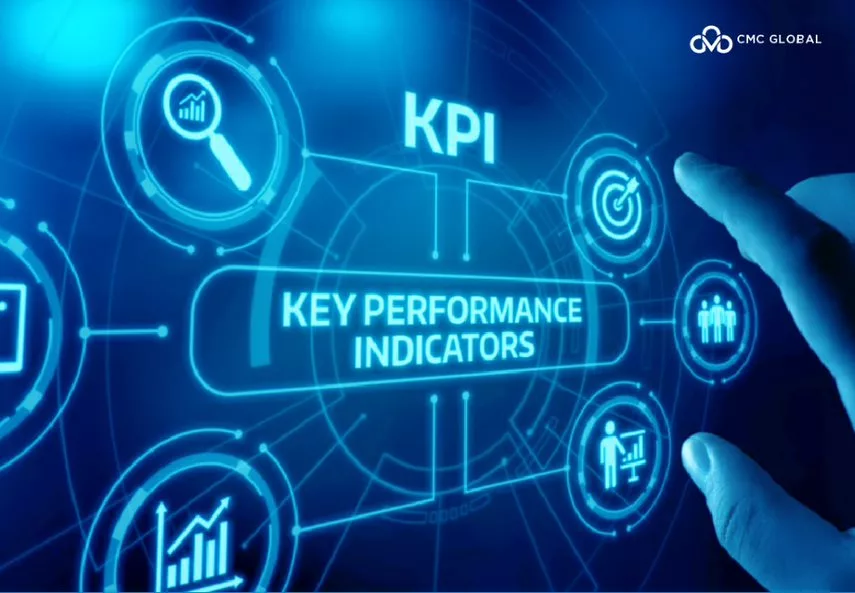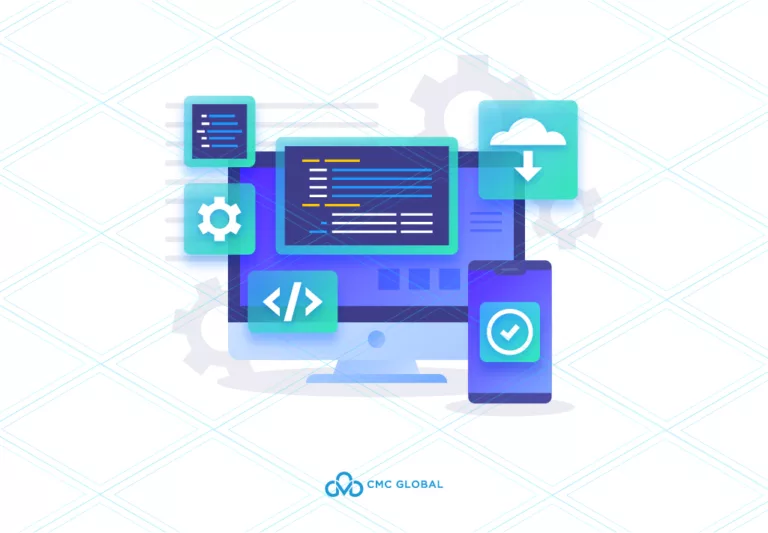What Is KPI In Software?
A Software Development KPI (Key Performance Indicator) is a metric used to quantify the activities of a corporation, company, organization, or individual divisions. In this case, it is used in terms of software development. These KPIs can help measure the success of a software development project and can be used to set operational, tactical, or strategic goals.
To ensure that KPIs accurately reflect the success of the project, the contractor or executor of the project must select appropriate software metrics. This selection process is essential as it determines which indicators are most important for the success of the project and which should be focused on.

KPIs in Software Development
It is important to note that business managers may not possess the technical knowledge required to fully understand software development. Therefore, it is crucial to rely on IT professionals to select appropriate metrics for KPIs.
Modern software development projects typically use highly flexible software, which includes continuous delivery, performance, and deployment. These metrics may not necessarily correspond precisely with your business goals. To gauge the success of development projects more effectively, it is crucial to adopt more refined and intricate software development KPIs. Based on this, KPIs for development teams should focus on the scalability of the business as a key component for performance. This approach ensures that high-quality work is delivered and can be demonstrated through the setting of accurate KPIs.
Why Is KPI For Software Development Important?
As with any endeavor, achieving objectives requires purposeful planning and execution. By establishing KPI engineering metrics and ensuring your team is dedicated to meeting them, you can ensure the creation of high-quality software while also increasing the likelihood of completing projects within budget and on schedule.
If issues arise, these metrics can serve as valuable indicators in pinpointing the problem. They also enable businesses to track and prioritize certain issues effectively.
Moreover, KPIs foster team productivity. When a development team has a clear understanding of their collective contributions and how they impact the outcome, they can more efficiently address obstacles.
Overall, incorporating an organized method of monitoring progress in your software development process will ultimately result in a higher ROI.
Types of KPI For Software Development?
This article will provide a brief walk-through of 3 types of KPIs — financial, customer, and software performance. Software development KPIs are broadly categorized into those 3 types.
1. Customer Metrics:
This measures customer satisfaction, retention, and efficiency, providing insights into customer behavior, such as the CLV (customer lifetime value) and customer acquisition cost (CAC).
2. Financial Metrics:
This type helps measure company profits and revenue, such as net profit and annual spending plans, while performance metrics measure how the company operates in all its departments, including the percentage of successful projects and the time spent on different processes.
3. Performance Metrics:
This type of metric can aid in prioritizing and relocating the resources more appropriately by reducing the percentage of projects requiring more attention and optimizing time spent on different processes.
By measuring these KPIs, businesses can identify areas for improvement and optimize their development processes.
e.g.: Customer Metrics can help predict customer spending and the efficiency of customer acquisition efforts, while financial metrics can help businesses stay profitable and competitive.
10 KPI For Software Developer Examples:
Enlist below will be the top 10 selected KPIs in Software Development that may prove beneficial to
your company’s use cases:
1. Velocity
Velocity in agile development refers to the amount of work completed by your team during a sprint – a designated period for completing specific tasks. There are several methods to measure velocity, with story points being the most widely used.
Story points measure the effort invested in a software product. The benchmarking is on a scale from 1 to 10, with 1 being the fastest task and 10 being the most sophisticated.
Estimating story points entails assessing the size and duration of a software project. On average, it takes three sprints to gain a clear understanding of your team’s average velocity. By utilizing velocity, it is possible to estimate the feasibility of the team’s objectives.
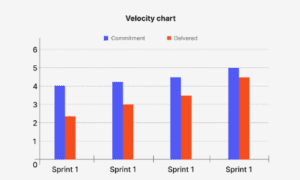
Velocity Chart
2. Sprint Burndown
The sprint burndown metric is a narrower measure than velocity and it calculates how much work is actually done during a sprint. Unlike velocity, which is an estimate based on several averages, sprint burndown is a software metric that allows teams to adjust their performance when the measurement does not match the predictions. Teams frequently use sprint burndown charts to monitor time against story points and represent data.
Sprint burndown is a helpful KPI that allows teams to adjust their performance when measurements don’t align with predictions. Companies often use sprint burndown charts to represent data, measuring time against story points. A story point is an assessment of a software project’s size and the required time.
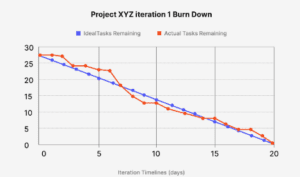
Sprint Burndown
3. Release Burndown
Release burndown charts have a similar appearance to sprint burndown charts, with the x-axis
representing sprints and the y-axis represents story points. Release burndown is a metric that tracks the progress of a software release and is more comprehensive than sprint burndown. It helps development teams manage product releases effectively. Using a release burndown chart, teams can determine if they are ahead, behind, or on schedule.
Software development teams can use release burndown KPIs to track their progress during product releases. These metrics are helpful in managing the release process and determining whether the team is on track or not. By using a release burndown chart, teams can obtain data to present to stakeholders about when they can expect their returns after the release. This KPI provides valuable information that can help businesses plan and update customers about any delays or early releases. This metric provides businesses with accurate data that they can use to inform stakeholders about the expected ROI post-release. It also enables businesses to keep their customers informed about delays or early releases.
An effective release burndown chart can aid in identifying the necessary sprints to finish the work.
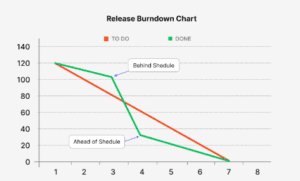
Release Burndown
4. Cycle Time
Cycle time is a valuable software metric that evaluates the duration spent on a specific task in software development. Development teams use cycle time charts to determine how productive their software development process is. Measuring cycle time offers several benefits, including an objective quantification of team performance, an estimation of future task completion speed, and the detection of inconsistencies that hinder a speedy workflow.

Cycle Time
5. Flow Efficiency
Flow efficiency is a software development KPI that calculates the proportion between the time you spend working actively on a task and the total time spent on it. It is essential to note that sometimes work in progress may not be progressing actively, and developers may experience waiting periods.
To calculate the flow efficiency KPI, you divide the active working time by the total cycle time. Low efficiency can indicate certain time periods when the work was slow, and understanding what caused these deficiencies can help in improving the process.
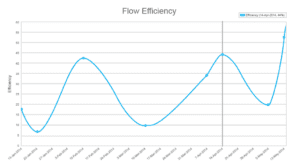
Flow Efficiency
6. Cumulative Flow
Software development processes can be complex and difficult to manage, with ongoing and upcoming tasks requiring streamlining for optimal efficiency. One useful tool in this regard is Cumulative Flow, which provides a visual representation of the status of software tasks or tickets.
Typically presented in table form, Cumulative Flow charts use different colors to indicate various stages of completion, such as ‘Approved,’ ‘In Progress,’ ‘Backlog,’ and others. These colors are arranged in bands, with the width of the band reflecting the cycle time.
By tracking software development progress in this way, development teams can more easily identify bottlenecks, monitor progress, and ensure that projects are moving forward smoothly and efficiently.
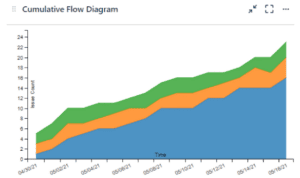
Example of CF diagram.
7. Code Coverage
Code quality is crucial in software development, and it often has a KPI assessment benchmarking – code coverage. This metric is important for development life cycles that prioritize test-driven development and continuous delivery.
Code coverage, also known as test coverage, measures the amount of source code that is executed during testing. Without execution during testing, Code may have hidden bugs. While achieving 100% code coverage may be unrealistic, higher coverage is generally better.
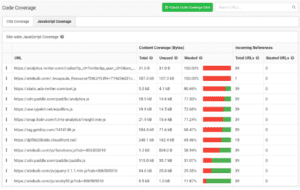
Code Coverage
8. Code Stability
Measuring code stability in software development can be challenging. Stable code refers to a software product with minimal changes that could negatively impact the business or software.
Different developers use different methods to measure stability. For example, some developers track the frequency of code changes, while others determine stability by the percentage of deployed code that results in downtime.
9. Code Simplicity
Essentially, the value of simple code that executes successfully is greater than complex code which requires extensive testing and refinement.
Code simplicity, as its self-explanatory name suggests, has a measurement of the number of independent paths that a code has.
10. Code Churn
Code churn is a metric common method to assess code stability, as it reflects how frequently code undergoes changes within a specific period. If a development team frequently needs to modify the code to fit in new features, it will result in a high-maintenance software system, posing a higher hazardous risk that calls for avoidance.
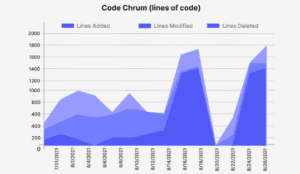
Code Churn
Conclusion:
Incorporating the software metrics and KPIs provided in this list is essential in your quest to elevate your business and optimize your software development process. For unmatched precision in your KPI measurements, why not join forces with CMC Global?
CMC Global is a highly accomplishing team with a wealth of expertise in attaining KPIs with remarkable accuracy. Entrust your software development aspirations to CMC Global.
Revolutionize your software development endeavors and bring them to new heights by engaging the services of CMC Global’s 2500+- developer team today!
>> REGISTER FOR CMC GLOBAL’S FREE CONSULTATION ON KPI FOR SOFTWARE DEVELOPMENT
With CMC Global, you will never have any difficulties in establishing and operating a development center. Contact us for further consultation.
